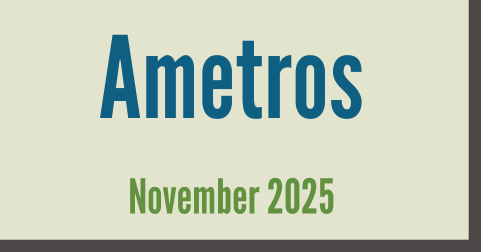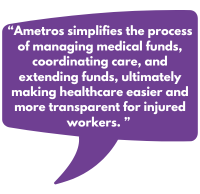IAIABC Member Spotlight
Each month, the IAIABC highlights one of its member organizations, asking about what the organization does; what challenges it sees workers' compensation facing; and why they're involved with the IAIABC. Find past member spotlights here.

IAIABC: Please provide an organizational overview (number of employees, years in business, vision)
Mark Long, Senior Vice President, Regulatory Affairs, Ametros: Ametros is a healthcare-focused organization with approximately 190 employees. It was founded in 2010, making it 15 years old. The company operates across the United States, serving injured individuals nationwide. Ametros’ organizational vision is to make healthcare easier for injured individuals, reflecting its commitment to simplifying post-injury care and support.

 IAIABC: How does your organization serve the workers’ compensation industry?
IAIABC: How does your organization serve the workers’ compensation industry?
ML: Ametros plays a vital role in the workers’ compensation industry by supporting injured individuals after settlement. The organization provides post-settlement medical management services that help individuals navigate their healthcare and ensure compliance with Medicare regulations. Ametros simplifies the process of managing medical funds, coordinating care, and extending funds, ultimately making healthcare easier and more transparent for injured workers.
IAIABC: What do you see as some of the major challenges the industry is facing, and how can we as a community address them?
ML: The workers’ compensation industry is navigating several significant challenges:
Complexity of Post-Settlement Care: Injured individuals often face difficulties managing their healthcare after settlement, especially when it comes to coordinating care and ensuring compliance with Medicare guidelines.
Ever-Changing CMS Regulations: The Centers for Medicare & Medicaid Services (CMS) frequently updates its policies and requirements, particularly around Medicare Set-Asides (MSAs). These changes have a significant impact on state policy makers as they establish settlement standards through statute, rules, and guidance. This interplay between states and CMS can create uncertainty and compliance risks for both injured individuals and industry stakeholders.
Lack of Education and Transparency: Many individuals are unaware of their responsibilities of post-settlement, leading to confusion and potential mis compliance.
As a community, we can address these challenges by staying informed and agile in response to CMS updates, ensuring our compliance strategies evolve alongside regulatory changes. Additionally, investing in education and advocacy empowers injured individuals with the knowledge and tools they need to confidently manage their care.
IAIABC: Are there any projects/programs/initiatives going on at your organization that you are particularly excited or enthusiastic about?
ML: We’re continuously working to improve the experience for our members through initiatives that simplify healthcare and support services. These efforts lead to meaningful impact for our members and help make life easier for those working in the workers’ compensation space.

IAIABC: What's an interesting fact about your organization that most people don't know?
ML: Each year, Ametros publishes the Member Impact Report, an annual review that showcases our member and client service performance, healthcare savings data, and the values and causes we champion. It’s a powerful reflection of the impact we make and the communities we support.
IAIABC: Why is your organization a member of the IAIABC? What would you tell others about the benefits of membership?
ML: Ametros values its IAIABC membership for the opportunity to connect with the regulatory community and gain insights that help us better serve our members. The networking and shared learnings are invaluable for staying informed and contributing meaningfully to the workers’ compensation space.
Previous Member Spotlights
2025 Member Spotlights
WCF Insurance - January 2025
Washington State Department of Labor and Industry - March 2025
Linea Solutions: Special Edition - April 2025
Enlyte - May 2025
Sentry Insurance - June 2025
Texas Department of Insurance, Division of Workers' Compensation - August 2025
Minnesota Department of Labor and Industry's Workers' Compensation Division - September 2025
Sapiens - October 2025
CadenceRX - November 2024
PERMA - October 2024
Workplace Safety and Insurance Board (WSIB) - September 2024
American Medical Association (AMA) - August 2024
Association of Workers' Compensation Boards of Canada (AWCBC) - July 2024
American Association of Payers, Administrators, and Networks (AAPAN) - June 2024
The Beacon Mutual - May 2024
Ohio Bureau of Workers' Compensation - April 2024
Arbicare - March 2024
Acuity Insurance - February 2024
Alaska Division of Workers' Compensation - January 2024
Harvard MedTech - November 2023
Cottingham & Butler Claims Services - October 2023
NCCI: Special Edition - September 2023
Kansas Workers' Compensation Division - July 2023
Workers' Safety and Compensation Board Yukon - June 2023
U.S.Able MCO - May 2023
MDGuidelines - April 2023
Workers' Compensation Research Institute - March 2023
Commonwealth of Massachusetts Department of Industrial Accidents - February 2023
Linea Solutions - January 2023
Idaho Industrial Commission - December 2022
Sedgwick - November 2022
Ebix - September 2022
Sikich - August 2022
Saskatchewan Workers' Compensation Board - July 2022
Colorado Division of Workers' Compensation - June 2022
FAIR Health - May 2022
Aerie EDI Group - January 2022
- Paradigm - December 2021
- Oklahoma Workers' Compensation Commission - November 2021
- ODG by MCG - September 2021
- Care Bridge International - June 2021
- Missouri Division of Workers' Compensation - May 2021
- California Workers' Compensation Institute - April 2021
- Iowa Division of Workers' Compensation - March 2021
- Nebraska Workers' Compensation Court - February 2021
- Verisk/ISO - January 2021
- Ohio Bureau of Workers' Compensation - December 2020
- The Workplace Safety and Insurance Board (WSIB) - November 2020
- VPay - October 2020
- National Council on Compensation Insurance (NCCI) - September 2020
- Optum - August 2020
- Utah Labor Commission: Division of Industrial Accidents - June 2020
- Healthesystems - March 2020
- Safety National - February 2020
- CompAlliance - January 2020
- California Self Insurers Security Fund - December 2019
- Wisconsin Worker's Compensation Division - November 2019
- The Black Car Fund - August 2019
- Pennsylvania Bureau of Workers' Compensation - July 2019
- NIOSH Center for Workers' Compensation Studies - June 2019
- Tennessee Bureau of Workers' Compensation - May 2019
- Florida Workers' Compensation Division - April 2019
- Concentra - February 2019
- Oregon Workers' Compensation Division - January 2019
- SFM - December 2018
- Montana Department of Labor and Industry Employment Relations Division - November 2018
- MyMatrixx, an Express Scripts Company - October 2018
- Virginia Workers' Compensation Commission - September 2018
- WorkComp Strategies - August 2018
- Michigan Workers' Disability Compensation Agency - July 2018
